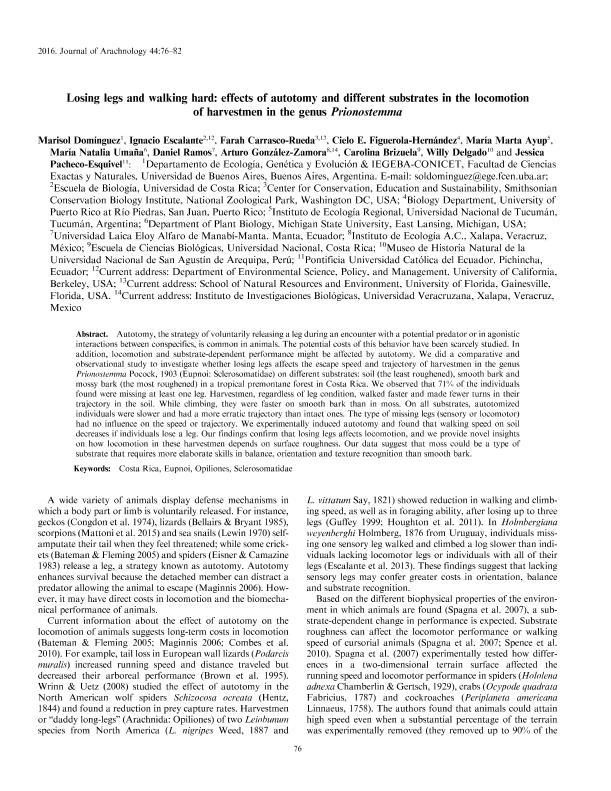Mostrar el registro sencillo del ítem
dc.contributor.author
Dominguez, Marisol

dc.contributor.author
Escalante, Ignacio
dc.contributor.author
Carrasco-Rueda, Farah
dc.contributor.author
Figuerola Hernández, Cielo E.
dc.contributor.author
Ayup, María Marta

dc.contributor.author
Umaña, María Natalia
dc.contributor.author
Ramos, Daniel
dc.contributor.author
González Zamora, Arturo
dc.contributor.author
Brizuela, Carolina
dc.contributor.author
Delgado, Willy
dc.contributor.author
Pacheco Esquivel, Jessica
dc.date.available
2018-09-26T18:25:32Z
dc.date.issued
2016-04
dc.identifier.citation
Dominguez, Marisol; Escalante, Ignacio; Carrasco-Rueda, Farah; Figuerola Hernández, Cielo E.; Ayup, María Marta; et al.; Losing legs and walking hard: Effects of autotomy and different substrates in the locomotion of harvestmen in the genus Prionostemma; American Arachnological Society; Journal of Arachnology; 44; 1; 4-2016; 76-82
dc.identifier.issn
0161-8202
dc.identifier.uri
http://hdl.handle.net/11336/60940
dc.description.abstract
Autotomy, the strategy of voluntarily releasing a leg during an encounter with a potential predator or in agonisticinteractions between conspecifics, is common in animals. The potential costs of this behavior have been scarcely studied. Inaddition, locomotion and substrate-dependent performance might be affected by autotomy. We did a comparative andobservational study to investigate whether losing legs affects the escape speed and trajectory of harvestmen in the genusPrionostemma Pocock, 1903 (Eupnoi: Sclerosomatidae) on different substrates: soil (the least roughened), smooth bark andmossy bark (the most roughened) in a tropical premontane forest in Costa Rica. We observed that 71% of the individualsfound were missing at least one leg. Harvestmen, regardless of leg condition, walked faster and made fewer turns in theirtrajectory in the soil. While climbing, they were faster on smooth bark than in moss. On all substrates, autotomizedindividuals were slower and had a more erratic trajectory than intact ones. The type of missing legs (sensory or locomotor)had no influence on the speed or trajectory. We experimentally induced autotomy and found that walking speed on soildecreases if individuals lose a leg. Our findings confirm that losing legs affects locomotion, and we provide novel insightson how locomotion in these harvestmen depends on surface roughness. Our data suggest that moss could be a type ofsubstrate that requires more elaborate skills in balance, orientation and texture recognition than smooth bark.
dc.format
application/pdf
dc.language.iso
eng
dc.publisher
American Arachnological Society

dc.rights
info:eu-repo/semantics/openAccess
dc.rights.uri
https://creativecommons.org/licenses/by-nc-sa/2.5/ar/
dc.subject
Costa Rica
dc.subject
Eupnoi
dc.subject
Opiliones
dc.subject
Sclerosomatidae
dc.subject.classification
Otras Ciencias Biológicas

dc.subject.classification
Ciencias Biológicas

dc.subject.classification
CIENCIAS NATURALES Y EXACTAS

dc.title
Losing legs and walking hard: Effects of autotomy and different substrates in the locomotion of harvestmen in the genus Prionostemma
dc.type
info:eu-repo/semantics/article
dc.type
info:ar-repo/semantics/artículo
dc.type
info:eu-repo/semantics/publishedVersion
dc.date.updated
2018-09-19T14:37:50Z
dc.journal.volume
44
dc.journal.number
1
dc.journal.pagination
76-82
dc.journal.pais
Estados Unidos

dc.journal.ciudad
Nueva York
dc.description.fil
Fil: Dominguez, Marisol. Consejo Nacional de Investigaciones Científicas y Técnicas. Oficina de Coordinación Administrativa Ciudad Universitaria. Instituto de Ecología, Genética y Evolución de Buenos Aires. Universidad de Buenos Aires. Facultad de Ciencias Exactas y Naturales. Instituto de Ecología, Genética y Evolución de Buenos Aires; Argentina
dc.description.fil
Fil: Escalante, Ignacio. Universidad de Costa Rica; Costa Rica
dc.description.fil
Fil: Carrasco-Rueda, Farah. Florida State University; Estados Unidos
dc.description.fil
Fil: Figuerola Hernández, Cielo E.. Universidad de Puerto Rico; Puerto Rico
dc.description.fil
Fil: Ayup, María Marta. Universidad Nacional de Tucumán; Argentina. Universidad Laica Eloy Alfaro de Manabi; Ecuador
dc.description.fil
Fil: Umaña, María Natalia. Universidad Nacional de Tucumán; Argentina. Michigan State University; Estados Unidos
dc.description.fil
Fil: Ramos, Daniel. Universidad Laica Eloy Alfaro de Manabi; Ecuador
dc.description.fil
Fil: González Zamora, Arturo. Universidad Veracruzana; México
dc.description.fil
Fil: Brizuela, Carolina. Universidad de Costa Rica; Costa Rica
dc.description.fil
Fil: Delgado, Willy. Universidad Nacional de San Agustín de Arequipa. Museo de Historia Natural; Perú
dc.description.fil
Fil: Pacheco Esquivel, Jessica. Pontificia Universidad Catolica del Ecuador; Ecuador
dc.journal.title
Journal of Arachnology

dc.relation.alternativeid
info:eu-repo/semantics/altIdentifier/url/http://www.bioone.org/doi/full/10.1636/J15-08.1
dc.relation.alternativeid
info:eu-repo/semantics/altIdentifier/doi/https://doi.org/10.1636/J15-08.1
Archivos asociados
